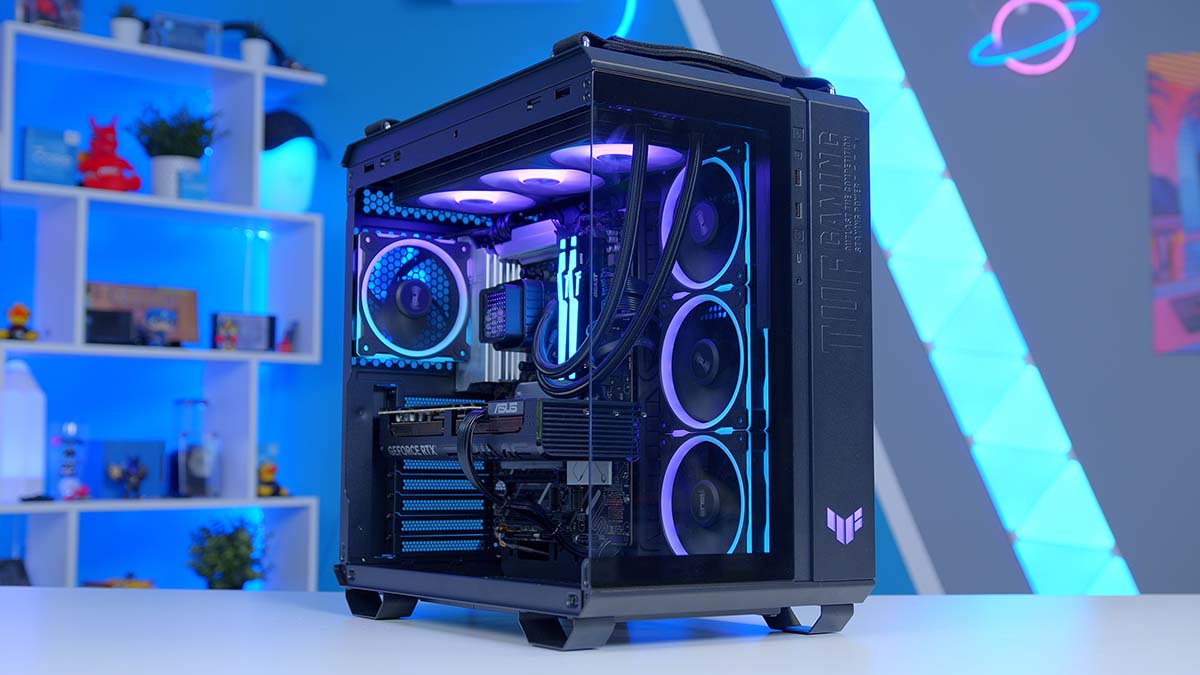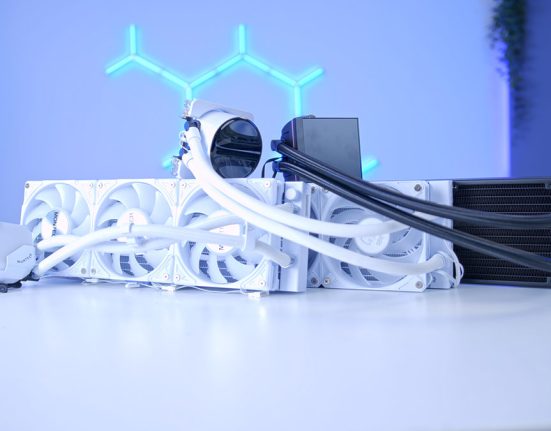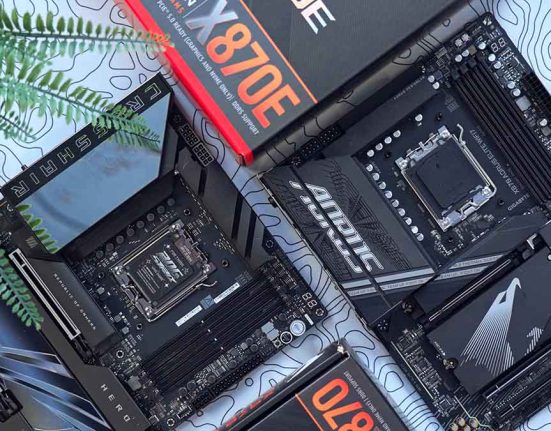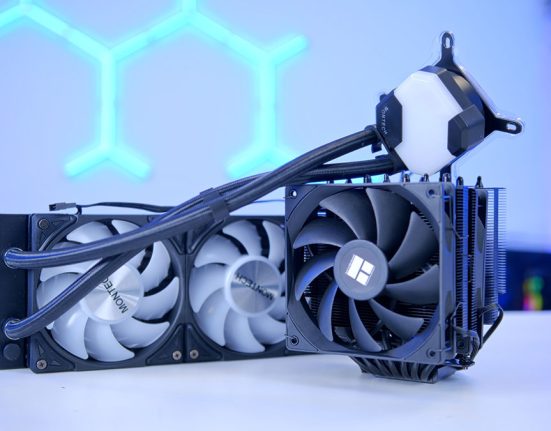This PC Build is a unique creation from GeekaWhat, marking our first foray into the world of flight simulators. Crafted for a client who wanted the ultimate flying experience! We didn’t want to leave you out on getting your hands on such an awesome rig, so we’ll tell you everything you need to know about all the components and peripherals used in this setup, as well as where to find them.
Whether you’re a seasoned aviation enthusiast or just getting started with flight sims, this setup pairs reliable simulation gear with a powerful custom all-ASUS PC to keep your virtual skies smooth and immersive. Should you have a more diversified taste in video games, this rig is sure to support other gaming styles with flying colours.
Virpil Flight Controls




We’ve been informed that Virpil Hardware is one of the best companies on the market for flight controls. James notes in the video that all of the buttons are fully allocatable, making your setup 100% customisable. The rig itself consists of several pieces of hardware, including the flight controllers and the frame used to mount them.
These are the Virpil controllers that we used: R1-FALCON Rudder Pedals, MongoosT-50CM3 Throttle, Universal Control Panel #2 and the Constellation ALPHA Prime [R]. Virpil focus on producing high-quality, highly durable, high-precision flight sim equipment with many available customisations and adjustments to suit any virtual pilot. The frame we used is a standard frame from a company called MONSTERTECH, a German company that specialises in high-quality flight and racing simulation solutions, ranging from pilot seats to joystick mounts.
Peripherals
Suppose the Simulator rig isn’t for you. In that case, we have handpicked some recommended peripherals below that are sure to give you complete control over your aircraft, allowing you to unlock your inner pilot’s full potential without compromising space or your bank account’s health.
Keyboard: ASUS ROG FALCHION ACE HFX
The ROG Falchion Ace HFX is a 65% analogue gaming keyboard with pre-lubed ROG HFX Magnetic Switches. It features several key components, including a Rapid Trigger toggle, Speed Tap Mode, and an interactive touch panel. It features an 8,000 Hz polling rate, ideal for competitive and precise gaming, where every keypress requires responsive feedback. Build-wise, it contains a five-layer damping system and silicone gasket mount, ensuring it remains quiet to minimise disturbance during gameplay.
It features ROG HFX Magnetic Switches that deliver a solid feel and are customisable between 0.1 and 4.0 mm actuation for instant keystrokes, providing those micro-adjustments where it matters and allowing you to have fine-tuned control and extra precision as an in-game pilot. The keycaps used are ROG PBT doubleshot with a UV coating. PBT keycaps are known for their durability, and the hard UV coating helps preserve the appearance and feel of the legends.

Mouse: ASUS ROG Keris II Ace Wireless
The ROG Keris II Ace is an ultralight 54-gram ergonomic gaming mouse with a shape tested by professional FPS players; it’s sure to provide a comfortable gaming experience without weighing you down or causing strain. It comes equipped with a 42,000-dpi ROG AimPoint Pro optical sensor, which again offers ultimate precision and is crucial for flying planes. The Keris II Ace can further enhance gaming performance with the ROG Polling Rate Booster, which supports polling rates of up to 4,000 Hz in wireless mode and up to 8,000 Hz in wired mode.
Headset: ASUS ROG Delta II Wireless
Every pilot needs a headset. Why not choose the ROG Delta II, a lightweight wireless gaming headset that provides cable-free, unrestricted movement? It boasts an exceptional battery life of up to 110 hours, and a 15-minute fast charge provides up to 11 hours of extra use at any given time. Another impressive feature is DualFlow Audio, which enables simultaneous connection to two devices. This means you can receive a phone call and answer it with a simple click of a button, without having to pause your game. The ROG Delta II is also ergonomically designed, weighing 318 grams and featuring two types of ergonomic D-shaped ear cushions for comfortable all-day gaming.

PC Components
CPU: AMD Ryzen 7 9800X3D

Here at Geekawhat, we love what this CPU has to offer. We’ve featured it many times in our articles, primarily due to its exceptional performance. It has 8 cores and 16 threads, which is perfect for flight simulator games where real-time physics calculations are constantly ongoing and multithreaded workloads are necessary to prevent the game’s framerate from tanking. This CPU lives on the latest Zen 5 architecture and AM5 chipset, making it compatible with cutting-edge motherboards and DDR5 RAM, securing the highest speeds and efficiency. It’s typically a CPU considered by PC enthusiasts, as it has higher specifications and is overclockable to 5.2GHz from a base of 4.7GHz. These numbers far surpass the standard for modern desktop PCs. It’s an absolute beast.
CPU Cooler: ASUS Prime LC 360 ARGB
With the type of workloads components, and more specifically CPUs, endure when playing flight simulator games, we must keep them cool to maintain efficiency and lifespan. Components can be particularly costly, and if they are not kept in suitable conditions, they will deteriorate, which is why we’ve chosen the ASUS Prime LC 360 ARGB cooler, especially considering the Ryzen 7 9800X3D tends to run quite hot.

The Prime LC 360 ARGB has a length of 360mm and comes with three pre-installed ARGB fans, hence the name. The specially designed copper contact area provides powerful heat dissipation, offering all-around optimal cooling. This cooler features an infinity mirror lens display, creating an optical illusion of captivating visual depth when the ARGB lighting is activated. Alternatively, it can be used to monitor sensor data for your internal components. The cooler is compatible with an AM5 chip CPU and offers compatibility with some Intel processors as well.
Motherboard: ASUS Prime X870-P
The ASUS Prime motherboards are specifically engineered to unleash the full potential of the AMD Ryzen 9000 series, making them a perfect match for the Ryzen 7 9800X3D processor used in this build. The motherboard features multiple fine-tuning options for your components and comprehensive cooling solutions. It is also DIY-friendly, with an almost tooless installation process concerning the components, utilising Q-release and latches for PCIe and M.2 slots. As mentioned, there are fine-tuning options, which include enhanced DDR5 support and performance with memory tuning options, maximising the potential of your RAM kit of up to 8000+MT/s using ASUS’ intuitive software.

For the theme and design, ASUS has chosen a celestial theme with little planet and line decals, and sleek, metallic surfaces for the metal shields on the motherboard. The PCB also follows the same theme, featuring a deep, achromatic black that likely represents space itself. Most of the slots have some customisation too, featuring the same metallic borders and even heterochromatic paired RAM slots. ASUS hasn’t been lazy with the design; it’s very aesthetic. The motherboard features RGB syncing options with Aura Sync, enabling you to synchronise your components in a harmonious lighting display, boosting the atmosphere and immersion within your gaming worlds.
| Specification | ASUS Prime X870-P |
| Form Factor | ATX |
| Supported Memory | 256GB, DDR5 at 8000+MT/s with overclocking for Ryzen. |
| PCI-E x16 Slots | 1 x PCI-E 5.0 2 x PCI-E 4.0 |
| PCI-E x4 Slots | 1 x PCI-E 5.0 2 x PCI-E 4.0 |
| PCI-E x2 Slots | 1 x PCI-E 3.0 |
| Front IO | 1 × USB 10Gbps Type-C 1 × USB 5 Gbps header supports 2 additional USB 5Gbps ports 2 x USB 2.0 headers support 4 additional USB 2.0 ports |
| Rear IO | 2 × USB4 40Gbps Type-C 1 × USB 10 Gbps Type-A 3 × USB 5 Gbps Type-A 4 x USB 2.0 Type-A |
| Audio | 3 x Audio Jacks |
| Networking | 1 x Realtek 2.5Gb Ethernet ASUS LANGuard |
The Prime X870-P features support for PCIe 5.0 in both x16 and x4 configurations, with an impressive data transfer rate of up to 512 Gbps for the GPU and 128 Gbps for the M. 2 slots. The USB Type-C ports support the latest super-speed data transfer rates of 40 Gbps and 10 Gbps, enabling rapid data transmission and compatibility with the latest devices and drives.
RAM: Kingston Fury Beast 64GB
This PC is being built for a specific purpose: to play flight simulator games. Our components need to be suitable for that purpose. Games like Microsoft Flight Simulator 2024, Freelancers: Rogue Skies and Tower Simulator 3 – KDCA Airport are flight simulators on Steam that I found. All games recommend a minimum of 16GB of RAM, but 32GB is generally recommended, as this allows for smoother and more enjoyable gameplay.

Flight simulator games are typically open-world, where a vast number of in-game objects and textures are present at any given time. These objects require computational space to exist, and this is where RAM comes in, as it stores vast, high-resolution textures, simulates complex atmospheric and aerodynamic conditions, and loads large amounts of data for detailed world and city environments into temporary memory for quick access. This detailed real-time simulation of large-scale environments requires significant system memory to minimise stuttering and deliver a smooth, consistent experience, particularly in densely populated areas like airports and cities. Considering the above, having 32GB of RAM puts this system in the best position to meet the demand that games will have in the future as they get updated and produced.
Ultimately, the Kingston Fury Beast at a speed of 6000MT/s is a solid choice for a RAM kit. They feature Infrared Sync Technology, which keeps the vibrant, customisable lighting in perfect sync, and they support Intel XMP 3.0 and AMD EXPO, allowing them to be overclocked safely.
SSD: Kingston Fury Renegade G5 SSD 2TB

The Kingston Fury Renegade G5 is a lightning-fast Gen5 SSD with read speeds of 14,700MB/s and write speeds of 14,000MB/s, making it ideal for gaming, content creation, and other demanding applications. It utilises PCIe 5.0, allowing you to fully leverage the motherboard’s potential with this M.2, providing double the speed of its predecessor and increased bandwidth, without bottlenecking other hardware components you may have. We recommend 2TB as a standard for storage, as games are only growing in storage size, and you need enough room for OS and other applications, which can always be upgraded or expanded on later. Microsoft Flight Simulator 2024 needs 50GB of storage space. With DLCs, Windows 11, various games and applications, you can start to sum up why you need around 2TB.
GPU: ASUS Prime RTX 5070 Ti


We recommend the ASUS Prime RTX 5070 Ti with 16GB VRAM specifically, as this will also contribute to the texture loading times and storage that flight sims require, considering they tend to cover a vast space to render. This graphics card is factory overclocked, with the clock speed increased from the default 2497MHz to 2527MHz. The RTX 5070 Ti features a 256-bit memory bus, providing your rig with higher bandwidth and improved efficiency, another factor that is going to benefit your gameplay. This graphics card has AI-enhanced graphics and performance called NVIDIA DLSS 4, which produces Multi Frame Generation that enqueues AI-drawn high resolution frames to the screen alongside GPU-drawn frames, which takes a lot of the workload off of the GPU as it isn’t working so hard to produce high resolution frames constantly, and this results in significantly improved gameplay.
Case: ASUS TUF GT502 Horizon ARGB
This industrial-looking case is perfect for on-the-move gaming; however, it is a relatively wide Mid-Tower case. It comes with two woven straps that support up to 30 kg, making it easier to move the chassis around even when filled with components. It features a fully modular design, where most of its panels and mounting components are removable to facilitate hardware installation. The side panels are also toolless, allowing for easy removal with a simple button press. The ASUS TUF GT502 Horizon ARGB houses a rear chamber for air cooling that supports a 360 mm radiator. ASUS also boast the Boundless Panoramic Design of the glass panels, aiming to give you a seamless view unobstructed by a front pillar.


| Specification | ASUS TUF GT502 Horizon ARGB |
| Form Factor | Mid-Tower |
| Motherboard Support | ATX Micro-ATX Mini-ITX |
| Case Dimensions (L x W x H) | 285 x 450 x 446 mm |
| Front IO | 2 x USB 3.2 Gen1 Type-A 1 x USB 3.2 Gen 2×2 Type-C (20 Gbps) 1 x 3.5mm Combo Jack LED button Power button |
| PCI-E Slots | 8 Horizontal 3 Vertical |
| Colour | Black White |
| Max Clearance | 163mm Cooler Height 400mm GPU Length 200mm PSU Length |
| Drive Support | 4 x combo 2.5″/3.5″ bays |
| Fan Support | Top: 3 x 120mm Front: No support. Side: 3 x 120mm Bottom: 3 x 120mm Rear: 1 x 120mm Rear Chamber: 3 x 120mm |
| Radiator Support | Top: Up to 360mm Front: No support. Side: Up to 360mm Bottom: No support. Rear: Up to 120mm Rear Chamber: Up to 360mm |
| Pre-Installed Fans | Top: Not Installed. Front: Not Installed. Side: 3 x 120mm ARGB Bottom: Not Installed. Rear: 1 x 120mm ARGB |
The case comes pre-installed with four MR120 ARGB Fans: three reverse fans and one standard fan for optimal airflow, and these can be controlled through the Front IO on the case or with ASUS Aura Sync, just like any of the other ASUS components with RGB lighting. The case comes with a handy vertical GPU mount, which takes the stress away from a sagging GPU and allows for more clearance for the CPU cooler. For the Front IO, it is easily accessible as it is positioned in a vertical line running down the middle of the right-hand side of the front of the case. The Front IO features two USB ports, one USB Type-C port and a headphone jack. Overall, the build quality of this case is designed to be durable, as it is from the TUF series, known for its military-grade material composition- you’ll be able to move this chassis around with some confidence that it won’t break easily.
PSU: ASUS Prime 850W Gold
Finally, we come to the last component that we need, and this is the one that will make your PC come to life. The ASUS Prime 850W Gold features substantial power for the GPU and is actually recommended by ASUS as the ‘perfect companion’. We need to ensure that the PC is receiving enough wattage to power all of the components. The RTX 5070 TI requires approximately 750W, which is typically the primary consideration when selecting a power supply, as it is the most potent component. Aesthetically, this PSU IS flexible for either black or white setups, as you have the option to choose which colour you want to display. This is a nice consideration, keeping costs down in the long run. This PSU is ATX 3.0 and PCIe Gen 5.0 compatible, making it a good fit for this PC build. The ASUS Prime 850W Gold PSU features efficient, low-ESR capacitors to ensure efficient operation. This means it delivers up to 92% efficiency, resulting in less heat, reduced fan noise, and increased reliability.

Gallery
![PI_ [SR179] Flight Sim PC Build Gallery](https://3.10.58.239/wp-content/uploads/2025/08/PI_-SR179-Flight-Sim-PC-Build-Gallery-3.jpg)
![PI_ [SR179] Flight Sim PC Build Gallery](https://3.10.58.239/wp-content/uploads/2025/08/PI_-SR179-Flight-Sim-PC-Build-Gallery-4.jpg)
![PI_ [SR179] Flight Sim PC Build Gallery](https://3.10.58.239/wp-content/uploads/2025/08/PI_-SR179-Flight-Sim-PC-Build-Gallery-1.jpg)

![PI_ [SR179] Flight Sim PC Build Gallery](https://3.10.58.239/wp-content/uploads/2025/08/PI_-SR179-Flight-Sim-PC-Build-Gallery-6.jpg)
![PI_ [SR179] Flight Sim PC Build Gallery](https://3.10.58.239/wp-content/uploads/2025/08/PI_-SR179-Flight-Sim-PC-Build-Gallery-2.jpg)




![MPI_[DP055] SAMA V60 + 9070 Build Montage](https://geekawhat.com/wp-content/uploads/2025/12/FI_DP055-SAMA-V60-9070-551x431.jpg)



![FI_[DM78] Corsair Air 5400 + 5090 Gaming PC Build](https://geekawhat.com/wp-content/uploads/2025/11/FI_DM78-Corsair-Air-5400-5090-Gaming-PC-Build-551x431.jpg)